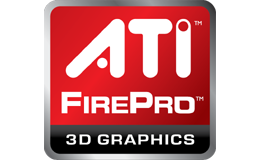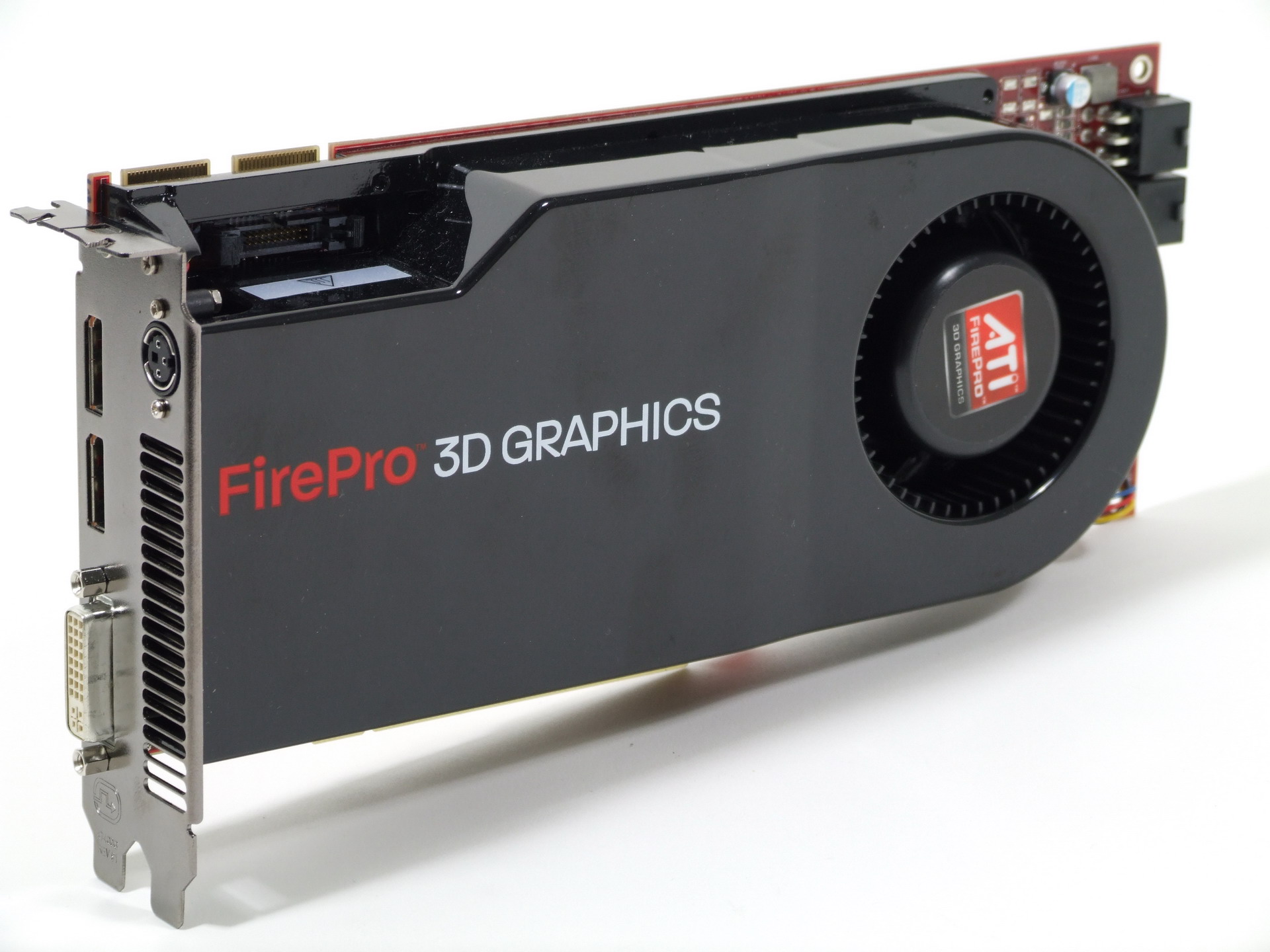AMD FirePro V8700: High-End Workstation Graphics
Introduction

AMD's RV770 graphics processor, so well-known for its use in gaming variants of the Radeon HD 4870, is now being used in the company's workstation graphics cards. At the same time, AMD has stepped away from its well-known FireGL brand; the most current professional graphics adapters now carry a FirePro label. Tom's Hardware has been lucky enough to score an early production model, the FirePro V8700, for comprehensive benchmarking.

The FirePro boards also mark a complete switchover by AMD from 80 to 55 nanometer manufacturing technology. Buyers should rejoice in that this means reduced power consumption, and correspondingly quieter cooling fans. But can a smaller die size and related technological advancements also improve performance?
Price is certainly a key factor here. At a price of $930 at Newegg, the V8700 is an astounding $284 cheaper than its predecessor, the FireGL V8600. Until this product hit the market, AMD's ATI division had always placed great emphasis on maintaining price-performance ratios across similar products of its own design.
Nvidia has historically been able to outperform similar ATI products at the highest end of its product offerings. These days, Nvidia buyers must be willing to settle for performance parity instead--for example, see our previous article, "Pro Graphics: Seven Cards Compared".
It's not completely clear to us why ATI has suddenly dropped the GL suffix from its Fire brand names, replacing that portion of that name with "Pro" instead. In discussions with product managers at ATI, we were repeatedly informed that "Pro" stands for "Professional" and thus better speaks to the goals of the workstation graphics group. Nevertheless, we believe that it can be risky to mess around with established brand names. Perhaps it makes more sense to see this move as a way of de-emphasizing differences between OpenGL and DirectX technologies? Either way, ATI has decided to switch its branding completely from FireGL to FirePro.
Market Overview
| Workstation Graphics Cards and their Mainstream Equivalents | ||||||
|---|---|---|---|---|---|---|
| Workstation-Model | Chip-Basis | Fab | Mainstream-Equivalent | Graphics RAM | 3-Pin Stereo | Display Port |
| ATI FirePro V8700 | RV770 | 55 nm | Radeon HD 4870 | 1024 MB GDDR5 | yes | yes |
| ATI FireGL V8600 | R600 | 80 nm | Radeon HD 2900 XT | 1024 MB GDDR4 | yes | no |
| ATI FireGL V7700 | RV670 | 55 nm | Radeon HD 3850 | 512 MB GDDR4 | yes | yes |
| ATI FireGL V7600 | R600 | 80 nm | Radeon HD 2900 | 512 MB GDDR3 | yes | no |
| ATI FireGL V5600 | RV630 | 65 nm | Radeon HD 2600 XT | 512 MB GDDR4 | no | no |
| Nvidia Quadro FX 5600 | G80 | 90 nm | GeForce 8800 | 1536 MB GDDR3 | yes | no |
| Nvidia Quadro FX 4600 | G80 | 90 nm | GeForce 8800 | 768 MB GDDR3 | yes | no |
| Nvidia Quadro FX 1700 | G84 | 80 nm | GeForce 8600 | 512 MB DDR2 | yes | no |
| Workstation-Model | MemoryBandwidth | DirectX | OpenGL | Shader Model | Core Clock | Memory Clock | Pixel and Vertex Processing |
|---|---|---|---|---|---|---|---|
| ATI FirePro V8700 | 115 GB/s | 10.1 | 2.1 | 4.0 | 750 MHz | 900 MHz | 800 SPUs |
| ATI FireGL V8600 | 111 GB/s | 10 | 2.1 | 4.0 | 675 MHz | 868 MHz | 320 SPUs |
| ATI FireGL V7700 | 72.0 GB/s | 10.1 | 2.1 | 4.0 | 775 MHz | 1125 MHz | 320 SPUs |
| ATI FireGL V7600 | 51.0 GB/s | 10 | 2.1 | 4.0 | 500 MHz | 510 MHz | 320 SPUs |
| ATI FireGL V5600 | 35.1 GB/s | 10 | 2.1 | 4.0 | 800 MHz | 1100 MHz | 120 SPUs |
| Nvidia Quadro FX 5600 | 76.8 GB/s | 10 | 2.1 | 4.0 | 600 MHz | 800 MHz | 112 SPUs |
| Nvidia Quadro FX 4600 | 67.2 GB/s | 10 | 2.1 | 4.0 | 500 MHz | 700 MHz | 112 SPUs |
| Nvidia Quadro FX 1700 | 12.8 GB/s | 10 | 2.1 | 4.0 | 460 MHz | 400 MHz | 32 SPUs |
Legend: SPUs = Stream Processing Units
Stay On the Cutting Edge: Get the Tom's Hardware Newsletter
Get Tom's Hardware's best news and in-depth reviews, straight to your inbox.
In this context, we also think it's wise to describe a couple of interesting software initiatives. When it comes to Nvidia's CUDA (Computer Unified Device Architecture) we can offer a comprehensive article. On the other hand, the competition offers its own AMD Stream Computing. We dig into this more deeply on the next page, and do likewise for the ATI FirePro V8700 hardware details.
Current page: Introduction
Next Page FirePro V8700 Hardware Details: DisplayPort Times Two-
Tindytim Can we get some BIOS hacks for the next review of Workstation cards? Since 99% of the cards are just Desktop variants with the drivers being the difference, all that's Needed is a BIOS hack.Reply
I'd love to see how the real thing would stack up next to a card with different BIOS. -
bvanveelen Is that 1% difference in hardware enough to give these big differences? If the firepro drivers could somehow be applied to a HD4870 would it give similar performance?Reply -
curnel_D TindytimCan we get some BIOS hacks for the next review of Workstation cards? Since 99% of the cards are just Desktop variants with the drivers being the difference, all that's Needed is a BIOS hack.I'd love to see how the real thing would stack up next to a card with different BIOS.Ok, so basically, we'd have to get ahold of a fireGL bios, and hack it into a 3850. If there was an equivilant to a 3870, I'd do it myself.Reply
Who's brave enough? :P -
Tindytim bvanveelenIs that 1% difference in hardware enough to give these big differences? If the firepro drivers could somehow be applied to a HD4870 would it give similar performance?That's what a BIOS hack will do. You change the BIOS of the 4870 card to that of it's workstation equivalent.Reply -
Antiphonal It's funny - my HD4870 is intentionally crippled in applications that I will not use so they can use a 5x price mark up for people who use those applications. /sighReply -
Tindytim curnel_dOk, so basically, we'd have to get ahold of a fireGL bios, and hack it into a 3850. If there was an equivilant to a 3870, I'd do it myself. Who's brave enough?Do a google search. It's been done before. Although I doubt this new card would yield any benefit over a 4870 with a BIOS hack, other than in some overclocking.Reply
I'd be more interested in the Nvidia card because then they at least add a little more VRAM. Hell, I'd love to see a Quadro card, with lots of VRAM, BIOS hacked to a Desktop variant to see how it would do at higher resolutions over the actual desktop variant. -
Harby AntiphonalIt's funny - my HD4870 is intentionally crippled in applications that I will not use so they can use a 5x price mark up for people who use those applications. /sighReply
You're clueless. The price premium is for the drivers themselves, not the hardware. No one crippled your gaming card. But no one optimized its drivers for workstation applications either. And these optimizations are not simple tweaks but massive and careful code to give you massive performance boost under very very specific applications.
You could go as far as saying that you're in essence buying an expensive piece of software as well and not just a graphics card. -
You should test the other way around also, how does workstation card perform in games? (Not possible maybe)Reply
-
Harby vixenistheshitYou should test the other way around also, how does workstation card perform in games? (Not possible maybe)Reply
Of course its possible. But at best performance will be equal, I would assume a bit worse, depending on whether FirePro drivers include the specific game optimizations catalayst includes or not. -
krazyderek Drivers and 3yr support aside, I really really really really would have liked to see the top 4870 1gb consumer card thrown in just for a reference point. It would do wonders to help justify the price markup to my boss that signs the purchase order.Reply
